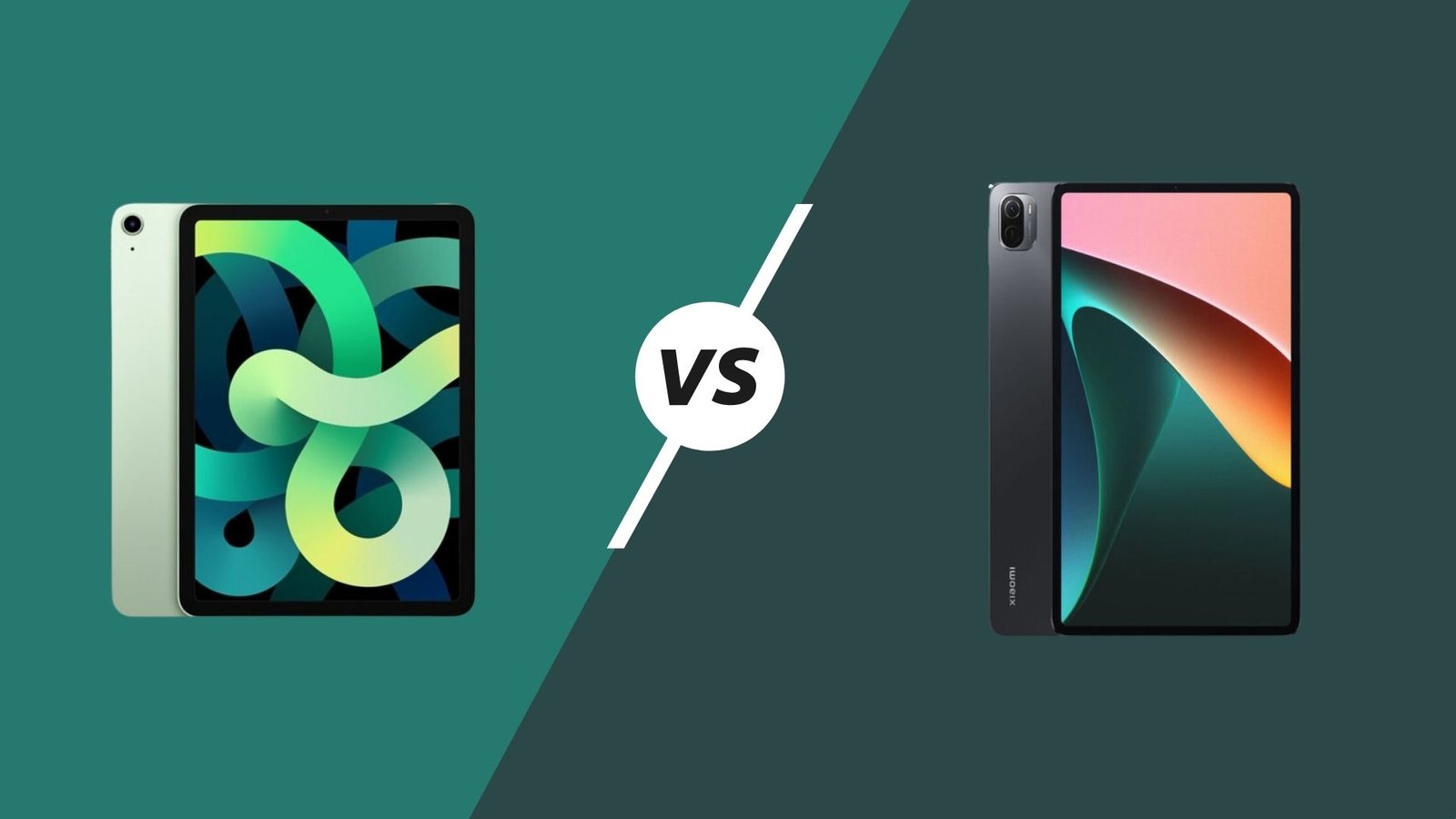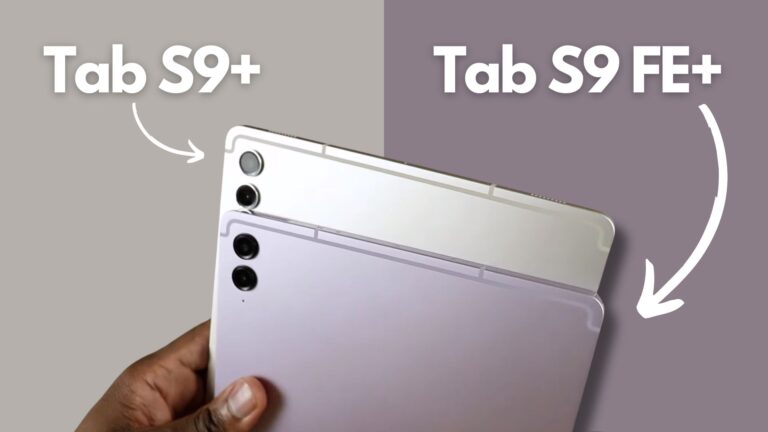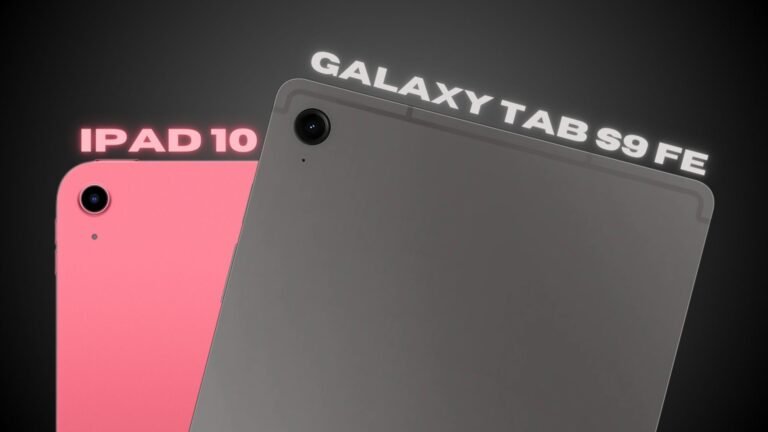Is the Xiaomi Pad 5 capable of competing with the iPad Air 4? Personally, I believe that tablet competition is beneficial to consumers because it forces manufacturers to compete with one another, resulting in better products.
| iPad Air 4 | Xiaomi Pad 5 |
 |  |
| BUY NOW | BUY NOW |
| PROS | PROS |
| All-screen design. Lots of power. Adventurous color choices. | Xiaomi’s software works great on large display. The screen looks fantastic. Impressive battery life. |
| CONS | CONS |
| 64GB storage is limited. Higher price than last-gen. Selfie camera could be better. | Selfie camera has an awkward placement. No headphone jack. Comes with no peripherals. |
iPad Air 4 vs Xiaomi Pad 5: SIZE, DESIGN, AND BIOMETRICS

When purchasing a tablet, the size of the device and the screen are two of the first things I consider. The iPad Air 4 is slightly wider, while the Pad 5 is slightly longer and 0.8 millimetres thicker than the previous generation. The Pad 5 has an 11-inch screen, compared to the iPad Air 4’s 10.9-inch screen. The Pad 5 is also 63 grams heavier than the previous generation.
Design-wise, the two tablets look very similar, with small bezels all the way around, rounded corners, and flat edges. There are some subtle differences, however. Both are beautiful and have a high-end feel to them. The iPad 5 has aluminium sides and a plastic back, whereas the iPad Air 4’s entire frame is machined aluminium.
Both tablets have power buttons at the top, volume controls on the right, and USB-C ports for charging and other accessories around the edges. Similarly, Connectors on both tablets allow them to communicate with keyboard cases.
It appears that there are two different approaches to biometric authentication. So, the iPad Air 4 has Touch ID built into the power button, and the Pad 5 has face unlock via the front-facing camera. It all depends on how you intend to use your tablet. Face unlock is faster than Touch ID because you don’t have to look for a button every time you want to use your phone, but it’s less secure.
iPad Air 4 vs Xiaomi Pad 5: DISPLAY

The iPad Air 4 has a 10.9-inch, 60-hertz display, with a resolution of 1640 by 2360, and an aspect ratio of 23:16. It’s a P3 display, which is a wider color gamut, and we’re getting 264 pixels per inch.
The Pad 5 has an 11-inch, 120-hertz display with a resolution of 1600 by 2560. It supports DCI-P3, has an aspect ratio of 16:10, and a pixel density of 274 pixels per inch.
The faster 120 hertz refresh rate on the Pad 5 is the first thing we notice. Things like app opening and closing and navigating the home screen and settings will feel faster and look better as a result. With Apple, this high refresh rate is currently only available on the 11 and the 12.9 inch models of the iPad Pro. To be clear, the Pad 5 does not have an adaptive refresh rate, like Apple’s ProMotion, which means that while you can select between 60 and 120 hertz on the Pad 5, the device will not alter its refresh rate in real time in order to optimise the viewing experience or preserve battery life based on what you’re currently viewing.
When it comes to watching YouTube or Netflix, the 16:10 aspect ratio on the Pad 5 is ideal because we’re getting a larger image with fewer black bars. When it comes to note-taking with the Apple Pencil, however, I prefer the iPad Air 4’s 3:2 aspect ratio because I have a little more room to work with.
Because their aspect ratios are so close, I’m not going to choose between the two in the end and give either one an advantage. It has a slightly higher pixel density, but not enough to be noticeable. Despite this, HDR10 and Dolby Vision are both supported.
iPad Air 4 vs Xiaomi Pad 5: AUDIO AND CAMERAS

Both devices have four speakers, two on each side, but the iPad 5 has four speakers while the iPad Air 4 only has two. In addition, the Pad 5 supports Dolby Atmos. Listening to the same songs or watching the same movie side-by-side with the Pad 5, it has a more full sound. At maximum volume, the sound is smoother and less distorted. Because neither has a 3.5 millimetre headphone jack, you’ll need to buy a USB-C headset or use an adapter if you want to game with wired headphones or a headset.
As for the front-facing camera, the iPad Air 4 has a 7-megapixel sensor versus an 8-megapixel sensor on the Pad 5. For video calls, they’re both fine in terms of quality.
The iPad Air 4 has a 12-megapixel rear-facing camera, while the Pad 5 has a 13-megapixel camera. Moreover, they both perform well on a tablet. I never use the tablet’s rear-facing camera because I have better and more convenient cameras on my phone.
iPad Air 4 vs Xiaomi Pad 5: ACCESSORIES

1. Stylus
Now it’s time to talk about the extras, starting with the stylus, which must be purchased separately in both cases.
The Apple Pencil 2nd Generation is compatible with the iPad Air 4, while the Xiaomi Smart Pen is compatible with the iPad 5. Both have a similar diameter, a flat edge, and a matte finish, making them quite comfortable to hold. And the sensation of the stylus tip striking the glass is very similar in both cases.
If you’ve only used the Samsung S-Pen, you’ll notice that both of these have a firmer feel when they come into contact with the glass.
The Apple Pencil is now longer and has a double-tap feature that you can assign a function to in the settings. Because the Smart Pen has two buttons, you can assign two different functions to it at the same time.
Both have proven to be extremely useful for taking notes, marking up documents, and sketching. My only criticism of the Smart Pen is that the buttons are a little too high, requiring me to reposition my grip every time I want to use them.
Both magnetically attach to the device’s side and charge it. They both pair wirelessly and require a charge to operate.
2. Keyboards
Now, as far as keyboards, the Pad 5 is compatible with the Xiaomi Pad Keyboard, while the iPad Air 4 uses the smaller Magic Keyboard or several great options from Logitech.
One advantage that I’m going to give the Magic Keyboard is that it has a track pad, which I really like, because it means that I don’t have to reach for the display every time I want to click.
iPad Air 4 vs Xiaomi Pad 5: PERFORMANCE AND BATTERY LIFE
The iPad Air 4 comes with the A14 Bionic chip, and both the 64GB and 256GB models come with 4GB of RAM. The Pad 5 comes with the Snapdragon 860, and both the 128GB and the 256GB models come with 6GB of RAM.
Geekbench Scores
| Xiaomi Pad 5 | iPad Air 4 | |
| SINGLE-CORE | 754 | 1111 |
| MULTI-CORE | 2754 | 2678 |
Real Life Usage
Now, a higher score indicates better performance, but I’m more concerned with real-world applications than with benchmarks.
For me, the iPad Air 4 has always been lightning fast and responsive. There is no lag for me, and switching between apps or scrolling is always fluid and smooth.
With the Pad 5, I wasn’t sure what to expect. And, for the most part, I’ve had a positive experience. The tablet is quick, and switching between multiple tabs in Chrome hasn’t been a problem. I can also have a lot of apps open at once and switch between them quickly.
Scrolling within a browser is one area where the iPad Air 4 consistently outperforms the iPad Air 3. So, despite the Pad 5’s 120 hertz, the iPad Air 4 felt and looked smoother. On the Pad 5, it wasn’t so much a refresh rate issue as it was lag and stuttering. So, in my opinion, the iPad Air 4 is the winner.
Multitasking
Split-view and additional popup, or Slide Over windows are available on both tablets, so you should be able to work with multiple apps at once. The Pad 5 slowed down when I was in split-view, which I noticed was one area where there was some friction.
The iPad Air 4, on the other hand, had no problems, regardless of which two apps I was using. In general, I prefer the iPad Air 4’s multitasking capabilities; they’re a little more refined, and the user experience feels more seamless and organic.
Gaming
So you won’t have any problems with either for basic gaming. What I was most interested in seeing how these tablets fared in more demanding games like PUBG and Genshin Impact.
As a result, Genshin Impact ran very smoothly on both tablets, with very little lag.
In PUBG, the difference is almost non-existent because I usually play on Smooth or Balanced for graphics and Extreme for frame rate. I also spent a lot of time on both tablets. The gameplay was silky smooth, and the graphics were stunning, with no odd scaling.
One thing I’d like to emphasise is that the iPad Air 4 was more comfortable to use because it lacked the sharp edges of the iPad 5.
Battery Life
The iPad Air 4 has a 7606 milliampere-per-hour battery, whereas the Pad 5 has an 8720 milliampere-per-hour battery. In addition, the Pad 5 has an advantage in real-world use. For what I do in a typical day, the battery life on my Air 4 is probably around 10 hours, versus upwards of 14 hours on the Pad 5.
Now, the Pad 5 has the advantage of supporting fast charging of up to 33 watts. So, if you get one, think about upgrading to a higher-capacity charger.
iPad Air 4 vs Xiaomi Pad 5: FINAL WORDS
The Xiaomi Pad 5 has a nice 120-hertz display, a powerful quad speaker system, plenty of processing power. It’s compatible with the Smart Pen and Keyboard. It does a pretty good job at multitasking and gaming, and it has good battery life.
The iPad Air 4 has a similar size display, a more refined app ecosystem. It uses more secure Touch ID for biometric authentication. It’s extremely smooth and responsive with single apps and when multitasking. We’re getting compatibility with the Magic Keyboard and the 2nd Generation Apple Pencil, and Apple is known for excellent long-term support for their devices.
Now, you should read how the iPad Air 4 compares with the Samsung Tab S8.






